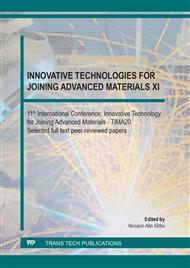[1]
Uday Sen, Kulbhushan Sharma, Friction Stir Processing of Aluminum Alloys: A Literature Survey, (2016) IJSRSET, Vol. 2, Issue 2, Print ISSN: 2395-1990, Online ISSN: 2394-4099.
Google Scholar
[2]
R.S, Mishra, M.W. Mahoney, Friction Stir Welding and Processing, pp.309-350, ASM International, The Materials Information Society, USA, (2007), ISBN 978-0-87170-840-3.
Google Scholar
[3]
R.S. Mishra, M.W. Mahoney, Friction Stir Welding and Processing IV, TMS The Minerals, Metals & Materials Society, USA, (2007), ISBN 978-0-87339-661-5.
Google Scholar
[4]
R.A. Behnagh, N. Shen, M. Abdollahi, H. Ding, Ultrafine grained surface layer formation of Aluminum alloy 5083 by Friction Stir Processing, Procedia CIRP 45 (2016), 243-246.
DOI: 10.1016/j.procir.2016.02.062
Google Scholar
[5]
U. Sen, K.Sharma, Effects of Process Parameters of Friction Stir Processing on Tensile Strength of AA6063 Aluminum Alloy", (2016) IJSRSET, Vol. 2, Issue 2.
Google Scholar
[6]
S. K .Singh, R.J. Immanuel, S. Babu, S.K. Panigrahi, G.D. Janaki Ram, Influence of multi-pass friction stir processing on wear behaviour and machinability of an Al-Si hypoeutectic A356 alloy, J Mater Process Technol, May (2016).
DOI: 10.1016/j.jmatprotec.2016.05.019
Google Scholar
[7]
W.H. Loke, R. Ibrahim, S. Lathabai, Improving the Microstructure and Mechanical Properties of a Cast Mg-9Al-1Zn Alloy Using Friction Stir Processing, Mater. Sci. Forum (Vol 838-839) online Jan. (2016), Trans Tech Publications.
DOI: 10.4028/www.scientific.net/msf.838-839.214
Google Scholar
[8]
Zhi Long Lu, Da Tong Zhang, Microstructure and Mechanical Properties of a Fine-Grained AZ91 Magnesium Alloy Prepared by Multi-Pass Friction Stir Processing, Mater. Sci. Forum (Volume 850),10.4028/www.scientific.net/MSF.850.778, online, March (2016).
DOI: 10.4028/www.scientific.net/msf.850.778
Google Scholar
[9]
O.O. Tinubu, S. Das, A. Dutt, J.E. Mogonye, s.a, Friction stir processing of A-286 stainless steel- Microstructural evolution during wear, Wear, Vol 356–357, (2016), p.94–100.
DOI: 10.1016/j.wear.2016.03.018
Google Scholar
[10]
R.S. Mishra, Use of Green Technology (FSP) for processing of 99.9% Copper with Carbon Nano Tubes, AJMECS, Vol. 1(1), January (2016): 49-59, ISSN (Online): 2455-7013.
Google Scholar
[11]
S. Thapliyal, D.K. Dwivedi, Study of the effect of friction stir processing of the sliding wear behavior of cast NiAl bronze: A statistical analysis, Tribol Int, Vol 97/(2016).
DOI: 10.1016/j.triboint.2016.01.008
Google Scholar
[12]
NanXu, YefengBao, Enhanced mechanical properties of tungsten inert gas welded AZ31 magnesium alloy joint using two-pass friction stir processing with rapid cooling, Mater. Sci. Eng. A655(2016)292–299.
DOI: 10.1016/j.msea.2016.01.009
Google Scholar
[13]
M. Navazani, K. Dehghani, Fabrication of Mg-ZrO2 surface layer composites by friction stir processing", J. Mater. Process. Technol., Vol. 229, March (2016), p.439–449.
DOI: 10.1016/j.jmatprotec.2015.09.047
Google Scholar
[14]
C.N. Shyam Kumar,Ranjit Bauri, Devinder Yadav, Wear properties of 5083Al–W surface composite fabricated by friction stir processing, Tribol Int 101(2016)284–290.
DOI: 10.1016/j.triboint.2016.04.033
Google Scholar
[15]
M. Rahsepar, H. Jarahimoghadam, The Influence of Multipass Friction Stir Processing on the Corrosion Behavior and Mechanical Properties of Zircon-Reinforced Al Metal Matrix Composites", Mater. Sci. Eng. A, 16 May (2016).
DOI: 10.1016/j.msea.2016.05.056
Google Scholar
[16]
R. Bauri, G. D. Janaki Ram, D.Yadav, C. N. Shyam Kumar, Effect of process parameters and tool geometry on fabrication of Ni particles reinforced 5083 Al composite by friction stir processing, Mater. Today: Proceedings 2 (2015)3203–3211.
DOI: 10.1016/j.matpr.2015.07.115
Google Scholar
[17]
R.Z. Valiev, T.G. Langdon, Principles of equal-channel angular pressing as a processing tool for grain refinement, Prog. Mater. Sci., 51 (2006), pp.881-981, Article PDF (4MB).
DOI: 10.1016/j.pmatsci.2006.02.003
Google Scholar
[18]
Y. Huang, T.G. Langdon, Advances in ultrafine-grained materials, Mater. Today, 16 (2013), pp.85-93, Article PDF (3MB).
Google Scholar
[19]
M.K.B. Givi, P. Asadi, Advances in Friction Stir Welding and Processing, Woodhead Publishing, Amsterdam (2014).
Google Scholar
[20]
M.St. Węglowski, P. Sedek, C. Hamilton, Experimental analysis of residual stress in friction stir processed cast AlSi9Mg aluminum alloy, Key Eng.Mater., 682 (2016), pp.18-23.
DOI: 10.4028/www.scientific.net/kem.682.18
Google Scholar
[21]
Vilaça, P., Santos, J. P., Góis, A., Quintino, L., Joining Aluminum Alloys Dissimilar in Thickness by Friction Stir Welding and Fusion Processes, Welding in the World, Vol. 49, No. 3/4, 56-62, (2005).
DOI: 10.1007/bf03266476
Google Scholar
[22]
Sorensen C.D, Nelson TW, Packer SM, Allen C., Friction stir processing of D2 tool steel for enhanced blade performance, Friction Stir Welding and Processing IV, TMS 2007 , 409-418.
DOI: 10.1002/9781118062302.ch43
Google Scholar
[23]
V. Verbițchi, L.N. López de Lacalle, G. Urbikain Pelayo, J.M. Pérez, a.o., New joining technologies for dissimilar materials, Tecnica y Tecnologia, Spanish Technology in Metalworking/3, No 56/2017, pp.38-46, ISSN 2014-8305, http://www.interempresas.net/Flipbooks/XM/52/html5forpc.html.
Google Scholar
[24]
L.N. López de Lacalle; G.Urbikain; I. Azkona; E. Zumalde; L. Okariz; V. Verbitchi; M. Vlascici, Alternative processes for rapid joining technologies, Welding and Material Testing, No.3/2016, Year XXV, ISSN 1453-0392.
Google Scholar


